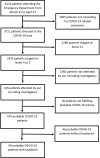Headache as a Cardinal Symptom of Coronavirus Disease 2019: A Cross-Sectional Study
- PMID: 32989732
- PMCID: PMC7646273
- DOI: 10.1111/head.13967
Headache as a Cardinal Symptom of Coronavirus Disease 2019: A Cross-Sectional Study
Abstract
Objective: To describe the semiology of pain and its associated features in patients with coronavirus disease 2019 (COVID-19) and headache presenting to the emergency department who do not require urgent services.
Background: Headache is one of the most frequent neurological symptoms reported in case series, epidemiological studies, and meta-analyses of COVID-19, with a prevalence ranging from 8 to 71.1%. Studies addressing the semiology of these headaches are lacking.
Methods: We conducted a cross-sectional study in the emergency department of a tertiary hospital. Patients classified according to the Manchester Triage System as standard and non-urgent and those fulfilling the criteria for probable or confirmed COVID-19 according to World Health Organization guidelines who presented with headache were included. A standardized questionnaire was used for data collection.
Results: Of the 145 confirmed and probable COVID-19 patients, 99 (68.3%) reported headache. A total of 54/99 (54.5%) were classified with probable COVID-19 and 45/99 (45.5%) with confirmed COVID-19. The mean age (44.7 ± 11.8 vs 40.4 ± 10.7, P = .061), sex distribution (35/54 [64.8%] vs 28/45 [62.2%] female, P = .768), and headache comorbidity (19/54 [35.2%] vs 17/45 [37.8%], P = .789) were similar between the probable and confirmed COVID-19 groups, along with other medical comorbidities and laboratory data. Patients with confirmed COVID-19 showed a higher incidence of anosmia (21/54 [38.9%] vs 28/45 [62.2%], P = .021) and pneumonia (10/54 [18.5%] vs 18/45 [40%], P = .018), headache at onset (32/54 [59.3%] vs 39/45 [86.7%], P = .002), and hospital admission (0/54 [0%] vs 2/45 [11.1%], P = .017). In most cases, the headache appeared simultaneously with other COVID-19 symptoms (57/99, 57.6%). It was bilateral (86/99, 86.9%), frontal or holocranial (34/99, 34.3% each) in location and intense (60/99, 60.6%, reported a visual analog scale [VAS] score ≥7). A total of 39/99 (39.4%) identified triggers, most commonly fever. The most frequent aggravating factors were physical activity (45/99, 45.5%) and coughing (43/99, 43.4%). Patients showed a propensity toward prostration (41/99, 41.4%), photophobia (29/99, 29.3%), and phonophobia (27/99, 27.3%). Partial (53/99, 53.5%) or total (26/99, 26.3%) responses to first-step analgesics were reported. A total of 25/99 (25.3%) patients had a prior history of migraine, presenting with headache different from the usual in 23/25 (92.0%) patients. Individuals with migraine were more likely to have earlier (headache at onset of the respiratory symptoms in 24/25 [96.0%] vs 57/74 [77.0%], P = .023 [95% CI: 0.067, 0.313]), longer (>24 hours of pain in 20/25 [80%] vs 25/74 [33.8%], P < .001 [95% CI: 0.272, 0.652]), and more intense (VAS score ≥5 in 25/25 [100%] vs 63/74 [85.1%], P = .043 [95% CI: 0.057, 0.213]) headaches than patients without migraine.
Conclusions: Headache is a very prevalent COVID-19 symptom among patients presenting to the emergency room, most frequently presenting as holocranial or bifrontal moderate to severe, and pressing quality headache. Individuals with migraine tend to present with earlier, longer, and more intense headaches.
Keywords: coronavirus; coronavirus disease 2019; headache; neurological; semiology; severe acute respiratory syndrome coronavirus 2.
© 2020 American Headache Society.
Figures





References
-
- Spain: WHO Coronavirus Disease (COVID‐19) Dashboard. Available at: https://covid19.who.int/region/euro/country/es. Accessed May 8, 2020.
-
- Tauber SC, Eiffert H, Brück W, Nau R. Septic encephalopathy and septic encephalitis. Expert Rev Anti Infect Ther. 2017;15:121‐132. - PubMed
-
- Ann Yeh E, Collins A, Cohen ME, Duffner PK, Faden H. Detection of coronavirus in the central nervous system of a child with acute disseminated encephalomyelitis. Pediatrics. 2004;113:e73‐e76. - PubMed
MeSH terms
LinkOut - more resources
Full Text Sources
Medical

